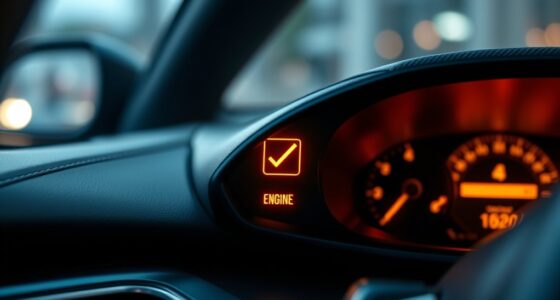At 30,000 miles, you should get oil changes, tire rotations, and inspections of brakes, belts, hoses, and spark plugs. At 60,000 miles, repeat these services and check cooling systems and fluid levels. By 90,000 miles, more extensive checks are needed, including parts replacement and detailed inspections. Regular visits help catch issues early and keep your car safe. If you want to make sure you’re covering all the essentials for each milestone, continue exploring the details.
Key Takeaways
- At 30,000 miles, expect routine tire rotations, oil changes, and brake pad inspections.
- At 60,000 miles, perform additional spark plug replacements and cooling system inspections.
- Maintenance at 90,000 miles often includes major component checks and possibly replacing belts or hoses.
- Regular inspections help identify wear early, prevent breakdowns, and ensure vehicle safety.
- Keeping detailed maintenance records and monitoring vehicle performance optimize longevity and reliability.

As you hit 60,000 miles, this is typically when you’ll encounter more thorough maintenance tasks. Besides repeating tire rotations and oil changes, you’ll want to check the condition of your brake pads, belts, and hoses. Your mechanic might recommend replacing spark plugs or inspecting your cooling system to prevent overheating. This stage is vital because the parts that keep your engine running efficiently start to wear out, increasing the risk of breakdowns if not addressed promptly. Regular inspections at this point can catch issues early, saving you money and stress later. Additionally, this is a good time to review your vehicle’s fluid levels—transmission fluid, power steering fluid, and coolant—to ensure everything is topped up and functioning properly. Monitoring your vehicle’s necessary and functional cookies can help optimize maintenance scheduling and vehicle performance.
Frequently Asked Questions
How Often Should I Check Tire Pressure Between Milestones?
You should check your tire pressure at least once a month and before long trips. Regular pressure checks help prevent uneven tire wear and improve fuel efficiency. During these checks, make sure to inspect for proper pressure and consider a tire rotation if needed. Maintaining correct tire pressure guarantees safety and extends your tires’ lifespan, so don’t forget to do this consistently between your scheduled maintenance milestones.
Are There Specific Brands Recommended for Replacement Parts?
When choosing replacement parts, you might wonder about brand recommendations. It’s smart to opt for reputable brands known for quality and reliability. Many drivers prefer OEM parts for their perfect fit, but quality aftermarket parts can be a cost-effective alternative. Research brands like Bosch, Denso, or Febi; they’re well-reviewed for durability. Always check reviews and consult your mechanic to guarantee you select the best aftermarket parts for your vehicle’s needs.
What Signs Indicate a Need for Immediate Maintenance?
Did you know that ignoring warning signs can lead to costly repairs? If you notice unusual noises, a burning smell, or warning lights, it’s time for immediate maintenance. You should get an oil change if your oil appears dirty or the engine runs rough. Also, schedule a brake inspection if you feel squeaking or reduced stopping power. Addressing these signs promptly keeps your car running smoothly and safely.
How Can I Improve My Car’s Fuel Efficiency?
To improve your car’s fuel efficiency, start with simple fuel saving tips like maintaining proper tire pressure and smooth acceleration. Consider eco-friendly upgrades such as installing a fuel-efficient air filter or upgrading to low-resistance tires. Regular maintenance also helps. These steps reduce drag and improve performance, saving you money and helping the environment. Stay proactive, and you’ll enjoy better mileage and a greener ride.
Is It Necessary to Follow the Manufacturer’s Recommended Maintenance Schedule Exactly?
Following the manufacturer’s guidelines is like steering a ship with a reliable map—you’ll stay on course. While strict adherence isn’t always necessary, maintaining essential services ensures your car runs smoothly. You can exercise some maintenance flexibility, but skipping key steps risks costly repairs down the line. Trust the manufacturer’s recommendations as your best guide, adjusting only if your vehicle shows specific needs or you’re advised by a trusted mechanic.
Conclusion
Keeping up with your car’s maintenance milestones is key to ensuring it runs smoothly for years to come. For example, imagine hitting 60,000 miles and realizing your car still runs like new because you followed the recommended service schedule. Regular checks at 30k, 60k, and 90k miles can save you from costly repairs down the road. Stay proactive, and your vehicle will reward you with reliable performance and peace of mind.









